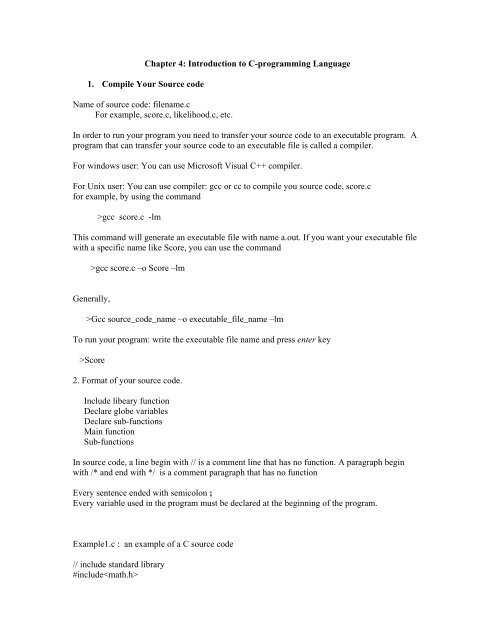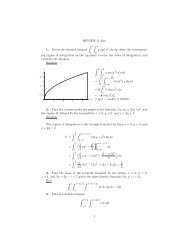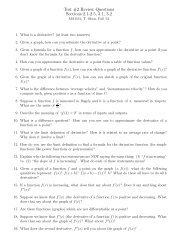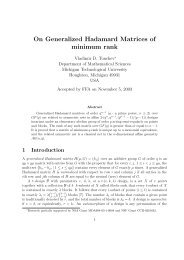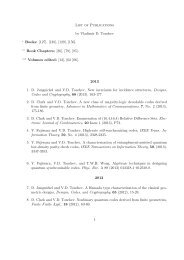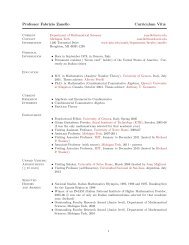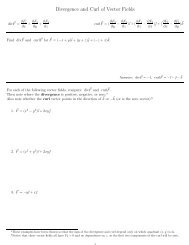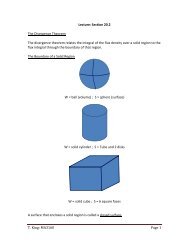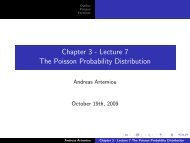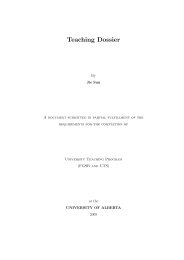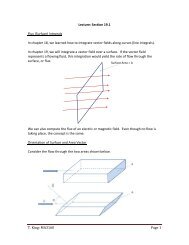Chapter 4: Introduction to C-programming Language 1. Compile ...
Chapter 4: Introduction to C-programming Language 1. Compile ...
Chapter 4: Introduction to C-programming Language 1. Compile ...
You also want an ePaper? Increase the reach of your titles
YUMPU automatically turns print PDFs into web optimized ePapers that Google loves.
<strong>Chapter</strong> 4: <strong>Introduction</strong> <strong>to</strong> C-<strong>programming</strong> <strong>Language</strong><br />
<strong>1.</strong> <strong>Compile</strong> Your Source code<br />
Name of source code: filename.c<br />
For example, score.c, likelihood.c, etc.<br />
In order <strong>to</strong> run your program you need <strong>to</strong> transfer your source code <strong>to</strong> an executable program. A<br />
program that can transfer your source code <strong>to</strong> an executable file is called a compiler.<br />
For windows user: You can use Microsoft Visual C++ compiler.<br />
For Unix user: You can use compiler: gcc or cc <strong>to</strong> compile you source code, score.c<br />
for example, by using the command<br />
>gcc score.c -lm<br />
This command will generate an executable file with name a.out. If you want your executable file<br />
with a specific name like Score, you can use the command<br />
>gcc score.c –o Score –lm<br />
Generally,<br />
>Gcc source_code_name –o executable_file_name –lm<br />
To run your program: write the executable file name and press enter key<br />
>Score<br />
2. Format of your source code.<br />
Include libeary function<br />
Declare globe variables<br />
Declare sub-functions<br />
Main function<br />
Sub-functions<br />
In source code, a line begin with // is a comment line that has no function. A paragraph begin<br />
with /* and end with */ is a comment paragraph that has no function<br />
Every sentence ended with semicolon ;<br />
Every variable used in the program must be declared at the beginning of the program.<br />
Example<strong>1.</strong>c : an example of a C source code<br />
// include standard library<br />
#include
#include<br />
#include<br />
#include<br />
#include<br />
// declare globe variable (not necessary)<br />
int nn, mm;<br />
double a,b;<br />
// declare subfunctions<br />
int sum(int n); /*this function calculate the sum of integers from 1 <strong>to</strong> n*/<br />
// main function<br />
main()<br />
{<br />
int m, i;<br />
for(i=1;i
sum from 1 <strong>to</strong> 9 = 45<br />
sum from 1 <strong>to</strong> 10 = 55<br />
First, include Standard library files<br />
math.h contains all the math functions such as<br />
sin(x), cos(x), asin(x), log(x), log10(x),<br />
exp(x), pow(x,y)=x^y, sqrt(x),<br />
ceil(x)=smallest integer not less than x<br />
floor(x)=[x]<br />
stdio.h contains functions related <strong>to</strong> input and output.<br />
stdlib.h contains utility functions<br />
string.h contains functions related <strong>to</strong> string like string copy<br />
ctype.h contains functions for testing charater<br />
for example isupper(c) return 0<br />
if c is not a upper-case letter otherwise retur non-zero.<br />
Second part: declare globe variables<br />
Third part: declare sub-functions or subroutines.<br />
Fourth part: Main function<br />
Fifth part: sub-function or subroutine.<br />
Loop:<br />
Sum 1 <strong>to</strong> n, we can use the following methods:<br />
<strong>1.</strong><br />
m=0;<br />
for(i=1;i=1;i--)<br />
{<br />
m+=i;<br />
}<br />
3.<br />
m=0;i=1;<br />
for(;;)<br />
{<br />
m+=i;<br />
i++; //or i=i+1;<br />
if(i>n)break;<br />
}<br />
Input and Output
Input and Output <strong>to</strong> screen:<br />
Command:<br />
Input: scanf Output: printf:<br />
Eamxple example2.c<br />
#include<br />
#include<br />
#include<br />
#include<br />
#include<br />
main()<br />
{<br />
int m;<br />
double a;<br />
char ch[100],cc;<br />
printf("please enter a character\n");<br />
scanf("%c",&cc);<br />
printf("the character is %c\n",cc);<br />
printf("please enter a integer\n");<br />
scanf("%d",&m);<br />
printf("the integer is %d\n",m);<br />
printf("please enter a real number\n");<br />
scanf("%lf",&a);<br />
printf("the real number is %lf\n", a);<br />
printf("please enter a string\n");<br />
scanf("%s",ch);<br />
printf("the string is %s\n", ch);<br />
}<br />
� gcc example2.c –o ex2 –lm<br />
� ex2<br />
The results will be<br />
please enter a character<br />
A<br />
the character is A<br />
please enter a integer<br />
2<br />
the integer is 2<br />
please enter a real number<br />
2.322<br />
the real number is 2.322000<br />
please enter a string<br />
zhang<br />
the string is zhang<br />
where, A in second line, 2 in 5 th line, 2.322 in 8 th line, and zhang in 11 th line are what your input<br />
in screen.
Input from and output <strong>to</strong> a file<br />
For example, you already have a data file with name hapdata.txt, and you want write something<br />
<strong>to</strong> a file output.txt<br />
First, Define a pointer ( with name fp for example) that points <strong>to</strong> a file: FILE *Fp;<br />
Then, open a file<br />
Open a file<br />
To read from<br />
Fp=fopen(“hapdata.txt”,”r”)<br />
To write <strong>to</strong><br />
Fp=fopen(“output.txt”,”w”) Or Fp=fopen(“output.txt”,”a”);<br />
If “w” is used and the file output.txt already exist, this command will overwrite the existed file.<br />
If “a” is used and the file output.txt already exist, the new things will be appended <strong>to</strong> the existed<br />
material.<br />
The standard method <strong>to</strong> open a file is as follow: (* denotes r, w, or a)<br />
if((Fp=fopen(“filename”,”*”))= =NULL)<br />
{<br />
printf(“can’t open file filename\n”);<br />
exit(1);<br />
}<br />
that is equivalent <strong>to</strong><br />
Fp=fopen(“filename”,”*”)<br />
if(Fp= =NULL)<br />
{<br />
printf(“can’t open file filename\n”);<br />
exit(1);<br />
}<br />
Write <strong>to</strong> or read from a file<br />
Use the commands<br />
fprintf(Fp, …..)<br />
fscanf(Fp, ….)<br />
The format is the same as printf () and scanf();<br />
See example3.c for detail.
Dynamically Allocate Memory S<strong>to</strong>rage<br />
Using utility sub-functions<br />
double * dvec<strong>to</strong>r(int ,int );<br />
int * ivec<strong>to</strong>r(int,int);<br />
double ** matrix( int, int, int,int);<br />
int ** imatrix( int, int, int,int);<br />
Free the memory s<strong>to</strong>rage<br />
void free_ivec<strong>to</strong>r(int *,int,int);<br />
void free_dvec<strong>to</strong>r(double *,int,int);<br />
void free_matrix(double **,int , int , int , int );<br />
void free_imatrix(int **, int,int,int,int);<br />
For example;<br />
int nn,mm;<br />
int *hap1, **HH; //declaration of integer vec<strong>to</strong>r ( int *) and integer matrix (int **)<br />
double *x, **A; //declaration of double vec<strong>to</strong>r (double *) and double matrix (double **)<br />
nn=100;<br />
mm=10;<br />
hap1=ivec<strong>to</strong>r(1,nn);<br />
HH=imatrix(1,nn,1,mm)<br />
x=dvec<strong>to</strong>r(1,nn);<br />
A=matrix(1,nn,1,mm);<br />
….<br />
free_ivec<strong>to</strong>r(hap1,1,nn);<br />
free_imatrix(HH,1,nn,1,mm);<br />
free_dvec<strong>to</strong>r(x,1,nn);<br />
free_matrix(A,1,nn,1,mm);<br />
An example example3.c<br />
#include<br />
#include<br />
#include<br />
#include<br />
#include<br />
#include "subfunction<strong>1.</strong>c"<br />
int RX,RY,RZ;<br />
int nsample, nmarker, **gen;<br />
/*<br />
nsample: number of sampled individuals<br />
marker: number of markers<br />
gen : matrix (i,j)th element is the genotype of
ith individual at jth marker<br />
*/<br />
int compHG(int *hap, int *sgen, int nmarker, int *hapcom);<br />
/* test if haplotype hap is compatible with genotype sgen.<br />
if hap is compatible with sgen, than find the haplotype hapcom<br />
such that hap and hapcom <strong>to</strong>gether is sgen<br />
*/<br />
void compatible( int *sgen, int nmarker, int *numall);<br />
/* find all haplotypes pairs compatible with genotype sgen<br />
and write all these haplotype pairs in a file<br />
*/<br />
main()<br />
{<br />
int i,j,nn,*numall;<br />
FILE *fp;<br />
nsample=200;<br />
nmarker=5;<br />
gen=imatrix(1,nsample,1,nmarker);<br />
numall=ivec<strong>to</strong>r(1,nmarker);<br />
for(i=1;i
=========================================================<br />
int compHG(int *hap, int *sgen, int nmarker, int *hapcom)<br />
{<br />
int i, indica<strong>to</strong>r;<br />
indica<strong>to</strong>r=1;<br />
for(i=1;i
}<br />
}<br />
sum++;<br />
fprintf(fp,"\nHaplotype Pair %d\n",sum);<br />
for(j=1;j


